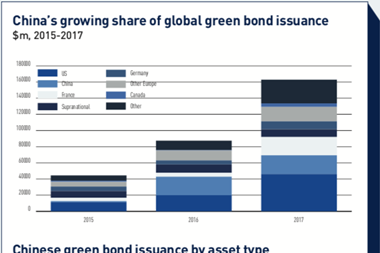Standard & Poor’s (S&P) economists expect cumulative inflows into China’s bond market to hit $500bn (€445bn) “in the next few years” as it opens up to overseas investors.
Inflows hit $300bn earlier this year, three times the level in 2015. This figure was almost zero just 10 years ago, according to a new report from the credit rating agency.
However, hitting half a trillion dollars by 2021 would still only account for 5% of China’s total bond market by today’s valuations, wrote S&P economists Shaun Roache, Vincent Conti and Vishrut Rana.
The Bloomberg Barclays Global Aggregate index – one of the most tracked fixed income indices in the world – added onshore Chinese bonds for the first time from 1 April.
“If China’s weight rises to 6% by 2021, as envisaged, this would imply inflows of $150bn,” wrote the S&P economists. “Other index providers are likely to follow suit, including FTSE Russell’s World Government Bond index, tracked by an estimated $2trn-$4trn of assets.”
“Getting ahead of this dynamic and incorporating it into financial decision making will make a substantial difference to performance”
Shaun Roache, Vincent Conti and Vishrut Rana, S&P
The authors said the size of China’s bond market and its gradual inclusion in mainstream indices could act as “a gravitational pull for foreign investors” that could increase China’s influence globally.
“As the share of foreign investors in China’s bond market rises, even a small change in the positioning of global fixed income managers in China could have large effects on bond yields and financial conditions across the rest of Asia Pacific,” they said. “Such changes could include expectations of a monetary policy shift.
“This new reality could change the region’s financial and credit cycle and, in turn, will affect real business cycles. We think getting ahead of this dynamic and incorporating it into financial decision making will make a substantial difference to performance.
“The US will remain the big beast but the dragon cannot be ignored… A new chapter has already begun.”
Further reading
Joseph Mariathasan: Accessing China’s bond markets
Despite China now being a main contributor to global trade and product integration, financial sector integration has been limited and China’s financial system, despite its size, also remains largely bank-based
‘Too big to ignore’: The rise of China’s $12trn bond market
Australian asset manager QIC Investment Management hails “excellent” prospects for growth, encouraged by the willingness of China’s national government to increase fiscal spending to offset any slowdown in private and local government investment









No comments yet